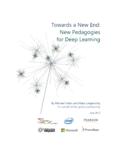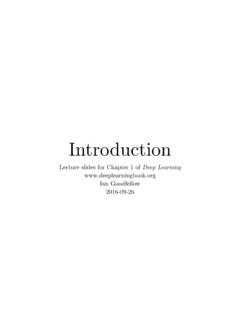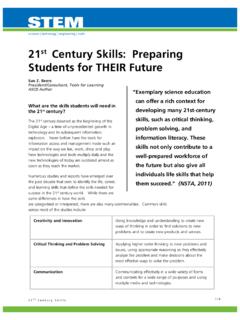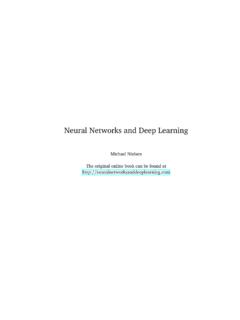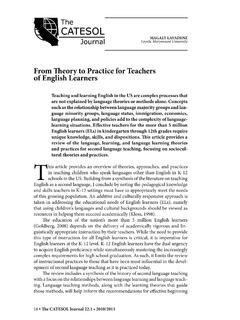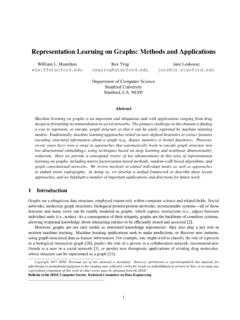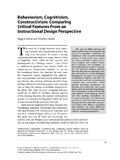Transcription of A force for school improvement - Michael Fullan
1 Michael FullanC e n t r e f o r S t r a t e g i c E d u c a t i o n S e m i n a r S e r i e s P a p e r N o . 1 5 7 , N o v e m b e r 2 0 0 6 Introduction 3 Section 1: Flawed change Theories 4 Section 2: Theories of Action with Merit 8 Section 3: Prospects for future use of change knowledge 13 References 14 change theoryA force for school improvementISBN 1 920963 35 9 Copyright Centre for Strategic Education, Victoria, 2006 The Centre for Strategic Education* welcomes usage of this publication within the restraints imposed by the Copyright Act.
2 Where the material is to be sold for profit then written authority must be obtained first. Detailed requests for usage not specifically permitted by the Copyright Act should be submitted in writing to:The Centre for Strategic Education, Mercer House, 82 Jolimont Street, Jolimont VIC 3002.(*The Centre for Strategic Education (CSE) is the business name adopted in 2006 for the Incorporated Association of Registered Teachers of Victoria (IARTV). Therefore, publications which were previously published in the name of IARTV are now published in the name of CSE.)Produced in Australia by Centre for Strategic Education, Mercer House, 82 Jolimont Street, Jolimont VIC 3002 Editorial Team:Tony Mackay, Keith Redman, Murray Cropley, George CiottiAcknowledgementMaterial presented in this paper is to be included in a forthcoming book, edited by John Burger, entitled General theory of Everything that Works in Education.
3 Ch a n g e t h e o r y: a f o rC e f o r s C h o o l i m p r o v e m e n t IntroductionChange theory or change knowledge can be very powerful in informing education reform strategies and, in turn, getting results but only in the hands (and minds, and hearts) of people who have a deep knowledge of the dynamics of how the factors in question operate to get particular results. Ever since Chris Argyris made the distinction between espoused theories and theories in use , we have been alert to the problem of identifying what strategies are actually in use (see Argyris, 2000, although he made this distinction much earlier).
4 In this paper I want to take this question a step further and ask what theories of action really get results in education reform. I also want to ask why, once identified, such successful theories are not embraced more widely? Having a theory in use is not good enough, of itself. The people involved must also push to the next level, to make their theory of action explicit, as it relates to the specific assumptions and linkages that connect the strategy to the desired outcomes. This paper is organised in three sections. Let me start by saying what I will not be doing in the paper. I will not focus on change theories that are obviously inadequate.
5 What I will be doing is focus on a number of change theories that look on the surface to have great merit but which, upon closer inspection, are seriously flawed and found wanting. I will be suggesting it is not that the strategies in question are wrong, but that it is more about them being incomplete, relative to what is needed for reform to work. Second, I will consider what theories of action appear to have more merit (ie, theories that are getting results) and discuss why that is the case. In the final section, I explore the prospects for using change knowledge more fully in the future. I also identify some barriers that may stand in the way of moving to a deeper set of strategies.
6 Having a theory in use is not good enough, of itself. The people involved must also push to the next level, to make their theory of action explicit Centre for Strategic Education Seminar Series Paper No. 157, November 2006If teachers are going to help students to develop the skills and competencies of knowledge-creation, teachers need experience themselves in building professional knowledge. Section 1: Flawed change TheoriesLet us take three current examples, all of which appear strong, and all of which are based on what their proponents would consider state-of-the-art change knowledge. These arestandards-based district-wide reform initiatives; professional learning communities; and qualifications frameworks that focus on the development and retention of quality leaders.
7 Standards-based district-wide reform initiativesTaking an example from the North American context, let s say a district receives a large grant from a foundation, to improve literacy and mathematics across all 150 or so schools in the district. Their change theory leads district leaders to include the following components in the strategy:identification of world class standards in literacy and mathematics;a system of assessments mapped on to the standards;development of curriculum based on the standards and assessments; and a serious investment in ongoing professional development, for school leaders and teachers.
8 What is wrong with this theory of action? First, what is the theory ? It assumes that, by aligning key components and driving them forward with lots of pressure and support, good things will happen, on a large scale. What is missing from the strategy is any notion about school or district culture. If theories of action do not include the harder questions Under what conditions will continuous improvement happen? and, correspondingly, How do we change cultures? they are bound to fail. Richard Elmore (2004) whom we will visit later in the paper, emphasises that educators must learn to do new things in the setting in which they work.
9 Standards-based reform by itself does not address changing the setting in which people illustrate further, we can take the heavily funded and supported reform initiatives in Chicago, Milwaukee and Seattle, as described in the detailed case studies from the Cross City Campaign for Urban school Reform (2005). All three school systems had the attention of political leaders at all levels of the system, focused on many of the right things, such as literacy and mathematics. In addition, all of the systems used obvious choice strategies, including concentration on assessment for learning data, invested heavily in professional development, developed new leadership, and focused on system wide they had money Seattle had $35 million in external funds, Milwaukee had extra resources and flexibility, and Chicago had multimillions.
10 There was huge pressure, but success was not expected overnight. Decision makers and the public would have been content to see growing success over a five-year or even ten-year period. The upfront conclusion of the case study evaluators was as follows.. the unfortunate reality for the many principals and teachers we interviewed is that the districts were unable to change and improve practice on a large scale. (Cross City Campaign, 2005, p 4)The issues in the Chicago, Milwaukee, and Seattle reforms help to identify the missing ingredient, even though they appear to get most components right.




